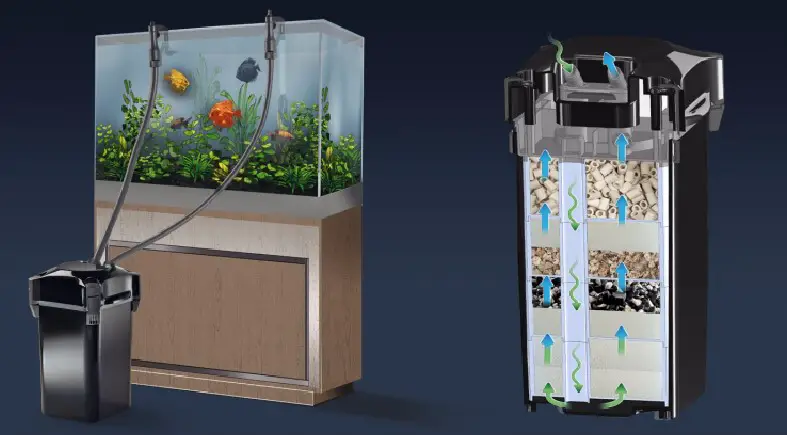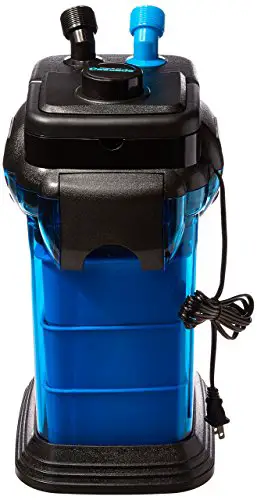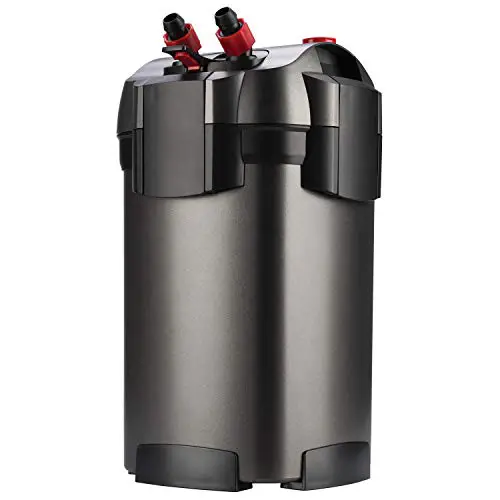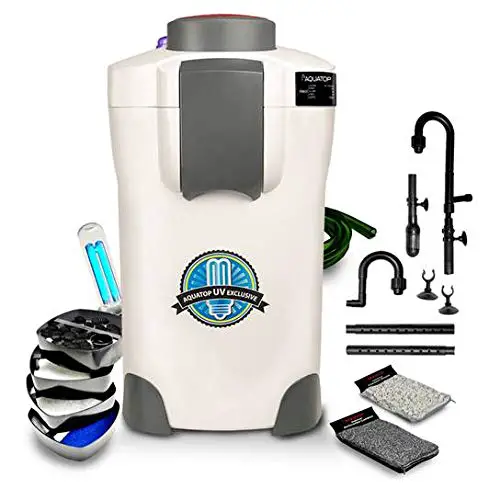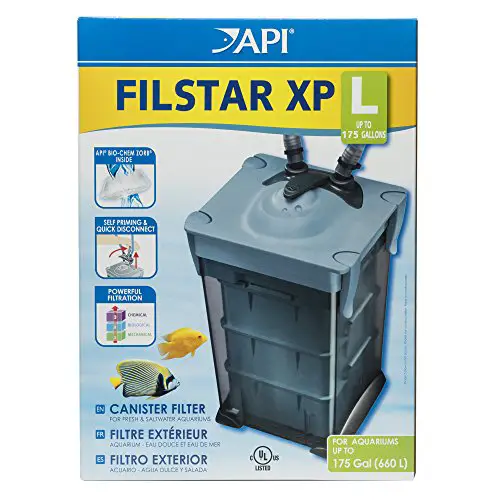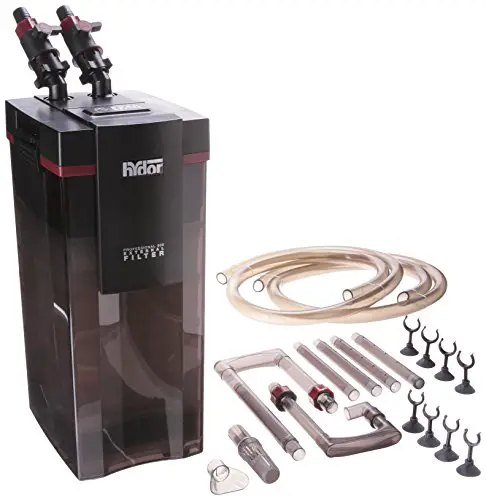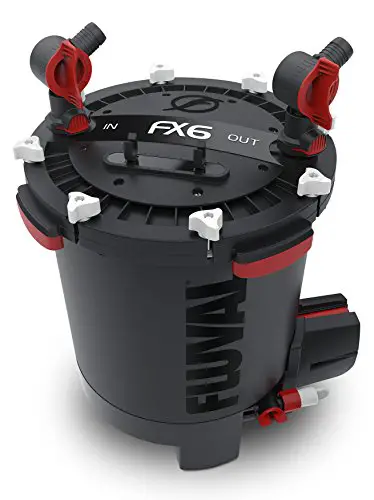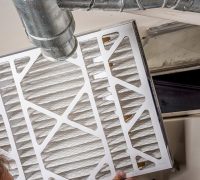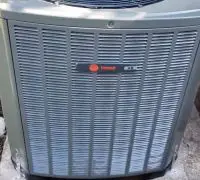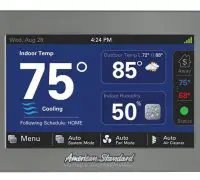There are many accessories that you can choose for your aquarium, but not all of them are fundamental. One of the things that your aquarium cannot do without is the filter.
Filters are essential since they maintain the water clean, removing all toxins that collect and possibly harm your fish.
The variety and types of filters are impressive, which is why it’s wise to give it a good thought before buying. Canister filters are quite a common choice as they’re efficient and more reliable than other types of filters.
Without any further ado, scroll down for our best selection of aquarium canister filters, buying guides and faqs.
Page Table of Contents
TOP 7 Best Aquarium Canister Filter
1. Finnex PX-360 Compact Canister Aquarium Filter
For the aquarists that have tiny aquariums (up to 25 gallons), the Finnex PX-360 Compact Canister Aquarium Filter will be a reliable filter to install.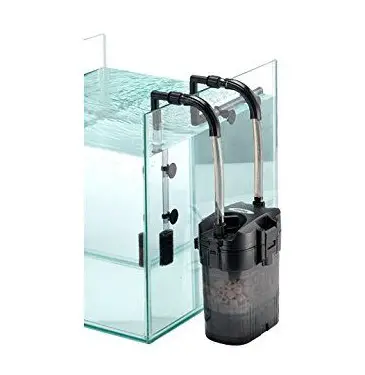
The filtration media contains sponge, activated carbon floss pad, and ceramic rings, so you shouldn’t stress out about its efficiency. The canister filter is quite a solid choice for aquatic and turtle aquariums on any given day. It comes with all accessories you may need for filtration, filter hanger, long-lasting water intake strainer, and spray bar, including.
Setting up the filter isn’t complicated, and its maintenance doesn’t pose any problems easy. You may safely install it in both saltwater and freshwater. The filtration chambers are easy to remove, so that you may add/remove the media the way you think it’s best.
Even if the filter comes with a powerful 95GPH motor, it runs quietly. The filter is made with ABS material and takes the use for a reasonable amount of time.
Let’s check the best parts once more:
- It’s reliable for both freshwater and saltwater aquariums
- It contains sponge, carbon floss pad, and ceramic rings
- The media trays are easy to remove for maintenance
- It’s powerful, yet silent when running
The downsides aren’t deal breakers for us:
- Some think that the build is rather cheap
- It doesn’t always run quietly
Not only that, the canister filter is reliable, easy to maintain and to use, but it’s also quiet and affordable. Why not give it a try?
2. Penn Plax Cascade Canister Aquarium Filter
Even if the price may seal the deal for many, the Penn Plax Cascade Canister Aquarium Filter brings to the table a lot more than just an affordable price.
Its popularity is impressive, and it’s definitely the overall value for the price that is the selling point for the filter.
The canister filter comes with flow valves that rotate 360degrees for comfortable handling even if the aquarium is tight. The media baskets are generous, and the large capacity lets you customize them according to your specific needs. The canister filter has a sturdy build and takes the use for a long time.
The design is smart, and the canister filter features a push-button for priming, which eases out and speeds up the priming. The package also includes a tubing, a spray bar, filter medium, and directional spout for adjustments. The construction is well thought and the canister filter with secure lift alignment clamps that ensure vacuum suction. The base is sturdy and tip-proof.
The canister filter comes with a floss pad for eliminating particulate matter and a coarse sponge that ensures enough surface for increased bacterial growth (it will remove both nitrites and ammonia).
Despite its power, the canister filter runs quietly, and it’s an excellent option for both freshwater and marine environments. It works at 265GPH, comes with three media baskets, and fits aquariums smaller than 100gallons. As the flow valves are easy to remove, maintaining the filter is effortless, especially since the intake, hose, and output remain at the aquarium.
Here’s what we like the most about it:
- It works for both freshwater and marine environment
- It includes a push-button primer for easy priming
- The three large media baskets allow customizing for the media
- It has a sturdy build, an ergonomic design, and runs quietly
The shortcomings are nothing to worry about:
- Some think that there’s too much bypass
- Not everyone feels that priming is easy to do
Affordable, dependable, and silent, the canister filter is a great choice and quite a bang for your buck.
3. Marineland Magniflow Canister Filter for Aquariums
Should you be looking for an affordable and reliable multi-stage filtration system, the Marineland Magniflow Canister Filter for Aquariums is one model to try.
The canister filter makes multi-stage filtration in both freshwater and saltwater aquariums quick and effortless. The design is excellent, and the top-sealing gasket ensures a tight seal. The lid is easy to remove for accessing the media baskets, and you only have to lift up for removing.
The stack and flow filter trays will push water through and not around, whereas the medium layers will ensure chemical, mechanical, and biological filtration. The self-priming startup is easy due to the quick-prime button, fillsing the filter chamber with water. The quick-release valve block turns the water flow off immediately, separating from the motor housing for quick and spill-free maintenance.
The polishing filter pad works as a water polisher, eliminating debris, whereas the ceramic rings and bio-filter balls create a multifaceted surface area for growing the bio spires. No worries about water impurities, discoloration, and odors thanks to the Black Diamond Carbon. As for the dirt and debris, the filter foam pads will take care of it.
The canister filter is easy to set up and to maintain. It runs quietly, and it’s worth every single penny.
Here’s our take on the pros:
- The canister filter ensures multi-stage filtration
- It has a top-sealing gasket for sturdy seal
- The lid is easy to remove for accessing the media baskets
- It’s easy to install and to maintain
The downsides shouldn’t make you change your mind:
- It doesn’t come with UV light
- The instruction could be more accurate
Since the good outweighs the bad by far, the canister filter may be the perfect addition for your aquarium, no matter if it’s freshwater or saltwater.
4. Aquatop CF Series Canister Filter
Designed to clean aquariums up to 175 gallons, the Aquatop CF Series Canister Filter is a 4+1 stage filtration system loaded with good things.
The canister filter pushes water at 525GPH and includes a 9-watt UV sterilizer, which eliminates dangerous bacteria and algae spores. It also comes with one coarse filter sponge for efficient mechanical filtration and three excellent filter pads. You get everything you need for the installation, and the three generous filtration media compartments let you add the media you like. Bio-ball, premium Activated Carbon, and ceramic rings are also part of the system.
Even if the filter is made with plastic, it presents a solid build and seems to take a long time use. Setting up the filter shouldn’t be a problem, especially if it’s not a premiere for you.
The canister filter runs quietly, and it’s excellent value for the price.
Let’s have another look at the best parts:
- It’s a 4+1 filtration system
- It comes with UV sterilizer
- It’s effective and reliable
- It’s silent and affordable
The pet peeves are minor:
- It’s not the best looking filter
- A newbie may have difficulties using the instruction since it’s not that helpful
Even if the canister filter isn’t the best in town, rest assured that you’re not going to be disappointed by the performance and value, especially considering the price.
5. API Filstar XP
The API Filstar XP ensures powerful filtration, keeping the water crystal clear for a healthy environment for your livestock and plants.
The canister filter presents self-priming, and the quick-disconnect features let you start/stop the filtration really easy when it’s time for maintenance. The anti-airlock system will reduce the risk for sudden filtration stops, whereas the anti-noise feature reduces the risk of vibration against the floor/cabinet. The patented anti-airlock system makes the re-prime unnecessary, and the filter doesn’t need manual siphoning nor hand-pumping for starting.
The canister filter has a generous capacity for filtration media and is able to stable flow rates, removing colors, odors, and compound three times more efficiently than only carbon. You can use the media of your choice, and the filter is safe for both freshwater and saltwater aquariums. Every basket can hold up to four different media pouches, and the inner dividers increase the versatility.
There is centralized control of all functions to remove the canister and not lose prime, and the self-locking water shut-off lowers the risk of accidental flow when cleaning the filter.
The heavy-gauge build has a durability feel, and the canister filter is dependable. The rubber base is large and keeps it in place, dampening vibration. The canister filter is quiet, but not silent and comes with everything you need for installation.
We should highlight the best parts:
- It’s powerful and has a sturdy build
- You can use all the media you like
- It includes several features for better performance
- It’s well made and comfortable to use
The downsides are only a few:
- Some expected to get more media
- The risk of leaks isn’t null
At the end of the day, the canister filter is reliable, versatile, powerful, and quiet. Why not take the plunge?
6. Hydor Professional External Canister Filter
Any aquarist looking for a complete eco-system should stop searching since the Hydor Professional External Canister Filter can do it all. The canister filter ensures mechanical, biological, and chemical filtration.
The priming is straightforward, and the telescopic intake tubes make it all easy. The filter pushes water at 345GPH, and its sturdy construction has a durability feel to it. The base features four rubber feet for better stability.
Setting up the filter goes easy, even for entry-level users. It’s not going to take you more than half an hour to do it, but make sure to go over the instruction first. It’s fundamental if you want to make all the connections correctly.
The capacity is impressive, and the filter can take a lot of water, and the size ranges from 40 to 150-gallon aquariums.
The hoses are flexible and easy to handles, whereas the screw-down ends to ensure secure connections. The spray bar is long, and the canister filter doesn’t disappoint.
Let’s check the best parts once more:
- It pushes a lot of water
- It provides chemical, biological, and mechanical filtration
- The setup is easy
- It has a sturdy build and seems durable
The shortcomings aren’t significant:
- The replaceable filter pads aren’t cheap
- It may get clogged
Wrapping it all up, we can honestly say that the canister filter is a wise investment and reliable equipment to use for your aquarium.
7. Fluval Canister Filter-FX6 Filter
Taking care of a large aquarium is more straightforward than entry-level aquarists may think, but it’s definitely more expensive. For instance, you need to open your wallet big for a reliable canister filter capable of filtering the water in your large aquarium. The Fluval Canister Filter, FX6 Filter (400 Gal), doesn’t come cheap, but it’s worth every single penny.
The filter pump is designed for 400-gallon aquariums, working for both freshwater and marine aquariums. It presents Smart Pump Technology for best filter performance, and it’s made with microchip technology that always controls and improves the pump’s performance. It’s a self-starting filter, and you only need to add water and plug it in. In order to ensure its efficiency, the filter will auto-evacuate the trapped air every 12 hours.
The multi-stage filter will move up to 925gallons (3500L) of water per hour. Setting up the filter is straightforward, and you only need to connect the hosing to output.
The media baskets are easy to remove, eliminating water bypass and holding up to 1.5gallons of media. You get all the media you need: mechanical, biological, and chemical.
The design and build are well-thought-out. The Aqua-Stop valves come with a leak-proof Click-fit attachment system, and the valves are placed at a 45-degree angle for effortless installation and rotation. The water flow is continuous thanks to the anti-clog and telescopic strainer. It’s also possible to adjust the Multi-Directional output nozzle for customizing the water flow.
The rubberized feet reduce the level of noise, and the filter is dependable for a long time.
We’ve shortened the pros to the following:
- It includes mechanical, biological, and chemical filtration
- It has a smart design and a sturdy built
- It’s easy to set it up and to maintain
- It’s adjustable on many levels and great for 400 gallons aquariums
The cons shouldn’t hold you back when buying:
- The risk for sucking fish isn’t null
- It’s not a cheap filter
Be that as it may, the canister filter ticks most boxes within the category, and it’s a wise investment to make in the long run.
What aspects to consider when selecting the canister filter for your aquarium?
Knowing how to select the canister filter for your aquarium is essential simply because you want your fish and plant to thrive, and not to struggle for a living.
You cannot just go ahead and buy the very first canister filter you see in store, so keep reading for the details:
- The motor
The motor is a fundamental part of the canister filter. It has to be strong enough to push the water through the filtration media, but the pump requires more of your attention.
You don’t want the motor to be loud, as it may ruin the smooth ambiance that the gentle movements of fish inside the aquarium.
- The type of your aquarium
Even if most canister filters are made for both freshwater and saltwater, you still need to double-check before buying. Should you ever consider switching between aquariums, you won’t have to change the canister filter if it’s made for both. You also need to get a self-priming pump so that you don’t worry about manual priming before the first use.
Also, focus on the efficiency of the motor, with models that come with an electronic circuit board that check the pump’s activity.
- Filter system
Most of the time, you should buy a canister filter that comes with a high number of filter stages. Make sure that your budget is generous, though.
A 3-stage filtration system is typically enough for an aquarium, but make the splurge with a multi-stage canister if your wallet is thick.
- The size of your aquarium
You need to double or triple size the canister filter for finding out the size of the canister filter. For a 50-gallon tank, you will need a 100 or a 150-gallon canister.
- Valve
Most units feature two valves: one for the intake and one for the output. You should select valves that come with adjustable flow control so that you may be able to control the amount of water that will be filtered.
During maintenance, the valves may be entirely closed, which makes priming useless (water will remain in the intake pipes).
Rotate valves also make a solid choice because they let you install the canister in all sorts of orientation.
- Flow rate
A high flow rate is reasonable since it circulated the water faster inside the aquarium. Take it with a grain of salt as you don’t want a fast flow rate in a small aquarium. If you do, the filter will end up clean recirculating water.
For a 25-gallon aquarium, you need less than 300 or 500GPH filters. Anything around this size will be too fast and too pricey for your aquarium. Most of the time, 100GPH will be enough.
- Efficient mechanical filtration
The primary purpose of the canister filter is to eliminate unwanted components from the water. A reliable canister filter should collect debris easily and stop it from going back into the aquarium. It’s what makes it efficient, to begin with.
- Easy cleaning
Maintenance is another factor when selecting the canister filter. You want one with a removable media basket and easy to open the lid. The less you need to handle and to do for cleaning, the easier it is going to be for you to maintain the filter.
- Versatility
Canister filters provide you several kinds of filtration media to choose from. The more you read about the media for the filter, the easier it is going to be for you to manage it in the long run. A filter that allows you to use various media is always a better option.
- Effortless installation
Setting up a canister filter is effortless nine times out of ten, but you can never be too sure. Always follow instructions from the user’s manual so that you set the filter correctly.
FAQs on aquarium canister filters
Q: Can the canister filter be the only filter for a saltwater aquarium?
A: Many aquarists only rely on the canister filter for their aquarium. Keeping it clean and maintained on a regular basis can help with its efficiency. However, many professionals recommend using mechanical filtration as well. If you want to improve the quality of saltwater, you may need to use chemical filtration too. Canister filters are reliable, but only to some extent, in the case of saltwater tanks and large aquariums.
Q: Can the canister filter increase the level of oxygen in water?
A: Water that stands still has low oxygen levels. Canister filters move the water so that the surface water (which is rich in oxygen) also gets to the bottom of the aquarium, therefore distributing oxygen throughout the entire aquarium.
Q: What’s the most common issue for canister filters?
A: The most typical problem for canister filters is caused by nitrate. Debris and detritus deposit and rot, decomposing inside the filter. The “nitrate factory” is impossible to avoid, especially in the case of saltwater aquariums. You must maintain the nitrate levels in a saltwater aquarium below 5ppm. Higher levels will lead to excessive algae growth. And even entry-level aquarists know that excessive algae are quite tricky to remove from an aquarium.
Q: How often does the canister filter need cleaning?
A: It’s totally fair to know how often your canister filter requires cleaning. It’s not a difficult question, and the answer is quite apparent. You need to clean it the moment you notice it’s filthy and requires cleaning. However, it’s essential to rinse the filter after cleaning the aquarium, ideally not the same day. Wait for a couple of days and even a week before you clean the canister filter.
Q: Can you prevent the canister filter from sucking fish?
A: You may be surprised, but your fish may not die when sucked by the canister filter (after all, there’s constant water flow). Needless to say, it’s better to be safe than sorry. The easiest way is to wrap a stocking around the intake or the whole subversive filter. The fine stocking mesh will cover the gaps, protecting the fish without altering the efficiency of the filter.
